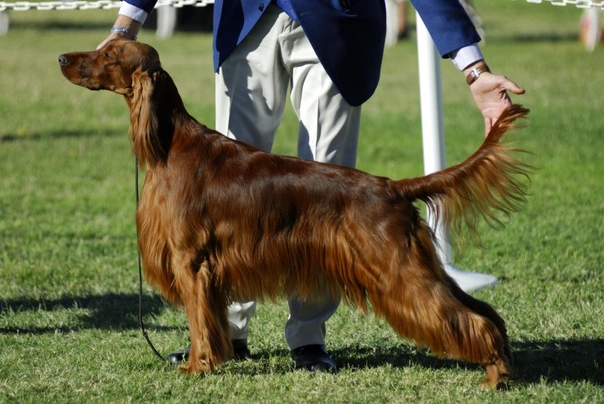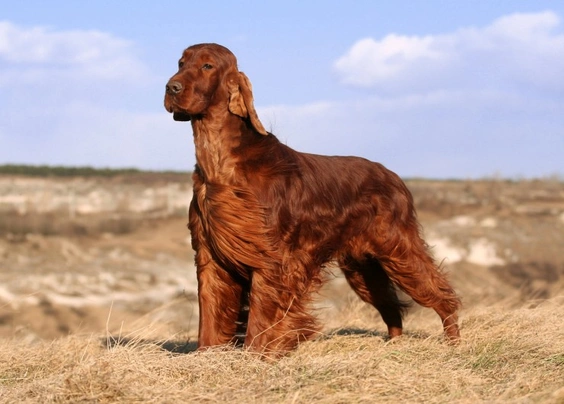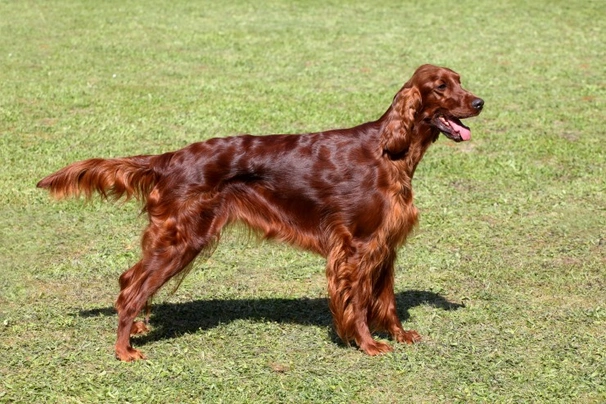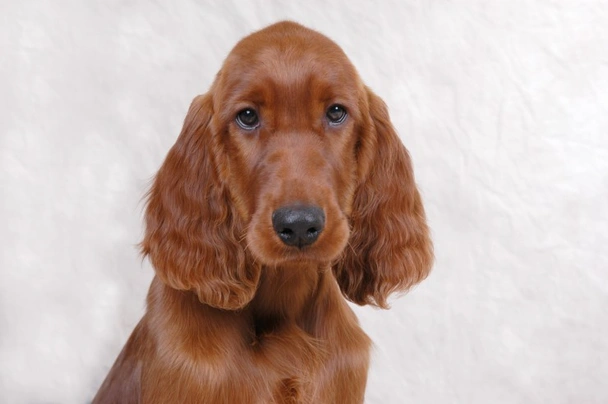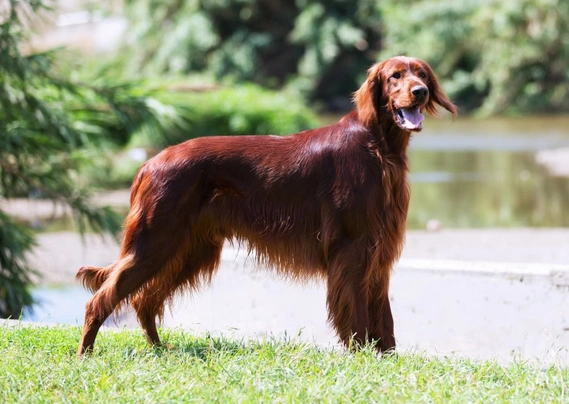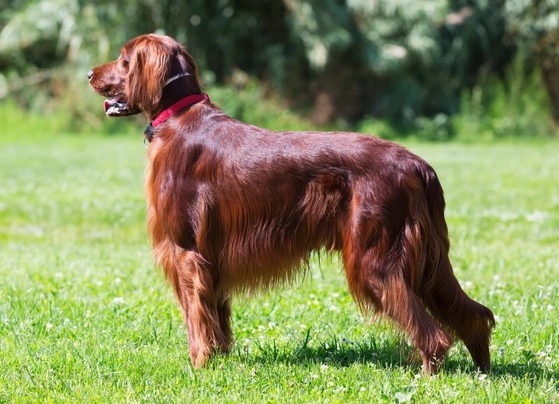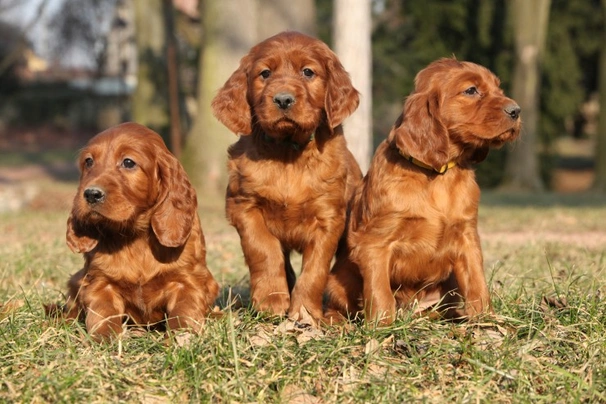Irish Setter
Pros
Cons
Introduction of the Irish Setter
Irish Setters are distinctly elegant looking Gundogs that over the years have consistently been popular in the show ring a home environment or as a working dog. Originally bred as working gundogs they must be among the most glamorous of dogs which means more often than not they are the focus of lots of attention from fans of the breed and other people too thanks to the gorgeously rich chestnut-red coats and their very kind natures.
These setters are among the oldest of their type around and were first bred in Ireland where they made their mark as being excellent gundogs although it should be said the Irish Setter is known to have a bit of a mischievous streak in them.
History of the Irish Setter
Being one of the oldest of the setter breeds the Irish Setter was around before English Setters or Gordon Setters appeared on the scene. They originate from Ireland where they were developed by crossing old-type spaniels setting spaniels and Scottish Setters. They were originally bred as hunting dogs and were to become excellent scent dogs. However the Irish Setters of yesterday were much like the dogs we know today and they boasted a mischievous side to their nature which often got the better of them when they were being put their paces and working.
The earliest record of a "setting dog" or "Setter" is in Caius's De Canibus Britannicus a publication that went to print in 1570 although the dogs described bear very little resemblance to the setters we see today being more like "spaniels" in looks. There are other references to Setters that appeared in 1616 which described them as being "other sorts of land spaniels that were known as Setters". By the 18th Century setters were fast becoming a popular dog and breeders began keeping records of their breeding practices. Breed enthusiasts included prominent families namely the de Freynes of French Park and Lord Dillon as well as the Marquis of Waterford.
In 1882 the first Irish Red Setter Club was established all thanks to the efforts of The Earl of Enniskellen who worked hard to breed only the best quality dogs. It was the Earl who developed the breed's striking solid red coat. With this said many dogs that were exhibited during this time still boasted white or black markings in their coats which was a throw-back to traits seen in the Gordon Red and White Setters.
The Irish Setter has always enjoyed a tremendous amount of success in the show ring thanks to their wonderful looks and hyper personalities and these charming dogs continued to do well until the breed was almost lost the 1940s thanks to the onset of an eye disease known as Progressive Retinal Atrophy which today is better known as PRA. Fortunately with the advancement in veterinary medicine it is now possible to have all Irish Setters DNA tested for this eye disorder and any dogs with the condition are never used in a breeding programme. This has helped increase breed numbers with fewer cases of dogs suffering from PRA over recent years.
Interesting facts about the breed
- Is the Irish Setter a vulnerable breed? No they are among some of the more popular breed in the UK both as family pets companions and working gundogs
- The first breed standard for all modern Irish Setters was established by the Irish Red Setter Club in 1886
- They are regarded as being an elegant example of a Gundog
- Irish Setters are known to be intelligent but they can also be quite independent when the mood takes them
- They mature slowly which means they remain very puppy-like for longer than most other breeds
Appearance of the Irish Setter
Height at the withers: Males 58 - 67 cm Females 54 - 62 cm
Average weight: Males 27 - 32 kg Females 24 - 29 kg
The Irish Setter boasts a very athletic and racy outline with a tremendous amount of power in their hindquarters. Despite their glamourous looks these setters are true working dogs and like nothing more than being given things to do. They are refined and handsome dogs that boast long lean heads which are slightly domed in between their ears. Their muzzles are quite long square and deep with strong jaws and wide nostrils with dogs boasting dark mahogany dark walnut or black noses.
Their eyes are almond shaped and dark hazel right through to dark brown in colour which are set level and which show a kind intelligent expression these dogs are known to possess. Ears are fine in texture and moderate in size being set low and well back. They hang neatly close to a dog’s head showing a neat fold. Irish Setters have a strong jaw boasting a perfect scissor bite where their upper teeth neatly overlap their lower ones.
They have moderately long well-muscled necks which dogs hold slightly arched adding to their proud looks. Shoulders are deep and sloping with fine points and front legs are sinewy and straight showing a lot of bone. They have deep chests which are quite narrow viewed from the front with well sprung ribs carried well back. Loins are muscular and slightly arched again adding a graceful dimension to the overall look of an Irish Setter. Their topline gently slopes away from the wither. Hindquarters are powerful and broad with dogs boasting strong back legs. Their feet are small firm with strong closed and arched toes. Tails are moderately long and set just below the level of a dog’s back. It is thicker at the root but tapers to the tip and dogs carry it level to their backs or just a tad below.
When it comes to their coat the Irish Setters boasts a superb long and silky one that’s free of any curls or waves. They have feathers on the upper parts of their ears on the back of their front and back legs as well as quite a bit on their undersides. Feet are also well feathered in between a dog’s toes and their tails boast having a fringe of long hair right to the tip. Their defining feature is their glorious rich chestnut coloured coat. Irish Setters can have a small amount of white on their chest throat chin toes as well as a very small star on their foreheads or a narrow streak/blaze on their noses. The accepted breed colour for Kennel Club registration are as follows:
- Red
Gait/movement
When an Irish Setter moves they do so with a free-flowing action showing a lot of drive from behind. They have a true action when seen from behind or from the front. When seen in profile Irish Setters are perfectly coordinated.
Faults
The Kennel Club frowns on any exaggerations or departures from the breed standard and would judge the faults on how much they affect a dog's overall health and wellbeing as well as their ability to perform.
Males should have both testicles fully descended into their scrotums and it is worth noting that a dog can be a little lighter or heavier as well as slightly taller or shorter than set out in the Kennel Club breed standard which is given as a guideline only.
Temperament of the Irish Setter
Irish Setters were originally bred to work as gundogs and although extremely good at the job they were bred to do they had a mischievous side to their natures which often got the better of them. However today these extremely attractive setters are known to be one of the most genuine dogs around boasting an affectionate friendly nature. They love nothing more than to be in a family environment and will join in all the fun and games that typically go on in a household.
They are quite excitable dogs by nature and always exhibit a fun-loving zest for life. They are a great choice for first time owners because they are easy to train all thanks to their desire to please. However because of the "naughty" side to their nature it takes time and patience to train an Irish Setter and their education needs to start early and be consistent throughout a dog's life for them to be truly happy relaxed and well-rounded dogs.
Irish Setters are high energy dogs and therefore owners must be able to give them the time these dogs need to be truly happy well-rounded dogs. This means lots of exercise and the right amount of mental stimulation to prevent boredom from setting in. A bored Irish Setter can get into all sorts of trouble especially when they find new things to entertain and amuse themselves around the home which typically involves destroying anything they find.
These dogs thrive on being around people and do not do particularly well when they are left to their own devices for long periods of time. They are also known to be quite accident prone all thanks to their quick turn of speed and the fact they can be very excitable at times. With this said when given enough exercise and lots of mental stimulation an Irish Setter forms a very strong bond with their owners but they do need to know their place in the pack. However as previously mentioned their training must start early and it needs to be consistent with a lot of emphasis being put on training an Irish Setter to respond to a "recall" command.
They are also known to like the sound of their own voices and have a reputation of being barkers when the mood takes them. The only way to avoid this from happening is to make sure an Irish Setter is kept busy and given heaps of mental stimulation. When talking about these dogs the saying a "tired dog is a good dog" is never truer. With this said these charming attractive dogs really do remain puppies at heart throughout their lives which should be taken into account when they are being put through their paces.
Although Irish Setters are a good choice as family pets they are not the best choice for families with young children or toddlers. The reason being that these dogs are often quite boisterous when they play which means they could end up knocking a toddler over and scaring them. Any interaction between children and an Irish Setter should always be supervised by an adult to ensure things stay nice and calm.
Are they a good choice for first time owners?
Irish Setters are a good choice for first time dog owners providing they have the time to dedicate to them bearing in mind that they can be a headstrong and therefore a bit harder to train than other breeds.
What about prey drive?
Irish Setters are very social by nature and even though they have working and hunting dogs in their lineage they do not have a very high prey drive. However this is not to say that a dog would not give chase to a smaller animal when the mood takes them and this includes squirrels and the cat from next door whenever they get the chance.
What about playfulness?
Irish Setters have a very playful side to their natures and love to entertain and be entertained. Younger dogs can be boisterous and accident prone which means teaching them to play outside rather in the house to avoid breakages bearing in mind that they mature very slowly.
What about adaptability?
Irish Setters are better suited to people who like to spend as much time in the great outdoors with a canine companion at their side. They do not do well living in an apartment because they benefit from being able to roam around a secure back garden whenever they can.
What about separation anxiety?
Although Irish Setters form strong ties with their families they don't mind being left on their own providing that it is never for too long. Puppies can be taught that being on their own is not something that should stress them out and they generally accept it when nobody is around although this should be done gradually when Irish Setters are still young.
What about excessive barking?
Irish Setters are known to be "barkers" and will voice their opinion about something when the mood takes them. With this said any dog that's left on their own for too long might start barking incessantly as a way of showing how unhappy they are at the situation. Puppies should be gently taught not to bark for the sake of it but this must be done gently because Irish Setters are so sensitive by nature.
Do Irish Setters like water?
Most Irish Setters love swimming and will take to the water whenever they can more especially when the weather is hot. However if anyone who owns a dog that does not like water should never force them to go in because it would just end up scaring them. With this said care should always be taken when walking an Irish Setter off the lead anywhere near more dangerous watercourses just in case a dog decides to leap in and then needs rescuing because they cannot get out of the water on their own. It is also very important to wipe a dog's ears dry to avoid any infections flaring up.
Are Irish Setters good watchdogs?
Irish Setters do not make good watchdogs although they are always very alert to what goes on around them and would be quick to alert an owner when something they don't like is going on. However rarely would an Irish Setter show any sort of aggressive behaviour when doing so preferring to keep their distance and bark. In short they are just too friendly to be thought of as “good watchdogs”.
Intelligence / Trainability of the Irish Setter
An Irish Setter's training needs to start as early as possible with a lot of emphasis being placed on the "recall" command as previously mentioned. They are not hard to train but their mischievous nature paired to a strong instinct to hunt can prove too much for them at times. However with a lot of patience and gentle persuasion the Irish Setter can be trained and some dogs compete and even excel when they take part in obedience trials.
The thing to bear in mind is that Irish Setters are sensitive dogs by nature and therefore they do not respond well to any sort of harsh training or correction. The breed is also slow to mature physically and mentally which must be taken into account when training them. Pushing a dog too hard will not achieve good results. However these setters are also known to be independent dogs and at times they can be a little stubborn and hardheaded.
Irish Setter puppies are very cute and they very sensitive too. It is all too easy to spoil puppies when they first arrive in their new homes but owners should always start out as they mean to go on which means setting ground rules and boundaries so that a puppy learns what is acceptable behaviour and what is not. All dogs like to know what an owner expects of them and they should be taught their place in the pack and who is the alpha dog in a household. The first commands an Irish Setter should be taught are as follows:
- Come
- Sit
- Stay
- Quiet
- Leave it
- Down
- Bed
Children and other
Irish Setters are known to get on well with children and will play nicely with them. They seem to have an affinity with small people but because of their size they could well knock a toddler over by accident which means any interaction between children and an Irish Setter should be supervised by an adult to make sure playtime does not get too boisterous.
Irish Setters generally get on well with dogs but when it comes to cats and other small animals they need to be introduced to them early in their lives and then grow up with them. The reason being their instinct might get the better of them when they encounter any small animals and cats. Care should be taken when an Irish Setter meets any small animals or pets they don’t already know.
Health of the Irish Setter
The average life expectancy of an Irish Setter is between 10 and 15 years when properly cared for and fed an appropriate good quality diet to suit their ages.
Although the Irish Setter is thought of as a healthy dog and one that boasts a longer life span than other dogs of their size there are certain hereditary and acquired disorders that owners need to know about if planning to share a home with one of these extremely handsome dogs. The health disorders that seem to affect the breed the most are as follows:
- Progressive retinal atrophy (PRA) - test available for rcd1 and rcd4
- Canine leukocyte adhesion deficient (CLAD) - test available
- Hip dysplasia - dogs should be hip scored under the BVA/KC scheme
- Epilepsy
- Bloat
- Entropion
- Megaesophagus (MO)
- Reproduction problems
- Rickets
- Wheat sensitive enteropathy
What about vaccinations?
Irish Setters puppies would have been given their initial vaccinations before being sold but it is up to their new owners to make sure they have their follow-up shots in a timely manner with the vaccination schedule for puppies being as follows:
- 10 -12 weeks old bearing in mind that a puppy would not have full protection straight away but would be fully protected 2 weeks after they have had their second vaccination
There has been a lot of discussion about the need for dogs to have boosters. As such it's best to talk to a vet before making a final decision on whether a dog should continue to have annual vaccinations which are known as boosters.
What about spaying and neutering?
A lot of vets these days recommend waiting until dogs are slightly older before spaying and neutering them which means they are more mature before undergoing the procedures. As such they advise neutering males and spaying females when they are between the ages of 6 to 9 months old and sometimes even when a dog is 12 months old.
Other vets recommend spaying and neutering dogs when they are 6 months old but never any earlier unless for medical reasons. With this said many breeds are different and it is always advisable to discuss things with a vet and then follow their advice on when a dog should be spayed or neutered.
What about obesity problems?
Some Irish Setters gain weight after they have been spayed or neutered and it's important to keep an eye on a dog's waistline just in case they do. If a dog starts to put on weight it's important to adjust their daily calorie intake and to up the amount of exercise they are given. Older dogs too are more prone to gaining weight and again it's essential they be fed and exercised accordingly because obesity can shorten a dog's life by several years. The reason being that it puts a lot of extra strain on a dog's internal organs including the heart which could prove fatal.
What about allergies?
Irish Setters are prone to suffering from allergies and it's important for a dog to see a vet sooner rather than later if one flares up bearing in mind that some dogs suffer from Wheat sensitive enteropathy. Allergies can be notoriously hard to clear up and finding the triggers can be challenging. With this said a vet would be able to make a dog with an allergy more comfortable while they try to find out the triggers which could include the following:
- Certain dog foods that contain high levels of cereals and other grain fillers
- Airborne pollens
- Dust mites
- Environment
- Flea and tick bites
- Chemicals found in everyday household cleaning products
Participating in health schemes
All responsible Irish Setter breeders would ensure that their stud dogs are tested for known hereditary and congenital health issues known to affect the breed by using the following schemes:
- BVA/KC Hip Dysplasia Scheme
- DNA test - CLAD
- DNA test - PRA (rcd1)
- BVA/KC/ISDS Eye Scheme
- DNA test - PRA (rcd4)
What about breed specific breeding restrictions?
The Kennel Club only registers Irish Setters that have been tested for CLAD and proven "clear" which applies to both parent dogs of puppies too.
The Kennel Club no longer accepts the registration of Irish Setters that are the offspring of parents that are CLAD carriers that have been mated to "clear" or to "hereditarily clear" parent dogs. Any breeder who would like to register puppies from carriers born after 1 January 2008 would need to get special permission before a mating takes place and the Kennel Club would deal with each case individually.
The Kennel Club will only accept registration of Irish Setters that have tested "clear" of PRA-rcd 1 - progressive retinal atrophy or where both parent dogs have proven clear of PRA which came into effect on 1st January 2010.
What about Assured Breeder Requirements?
It is mandatory for all Kennel Club Assured Breeders to use the following tests on their dogs and all other breeders are strongly advised to follow suit:
The Kennel Club also strongly recommends that all breeders use the following test on their dogs:
- Eye testing
- Bitches under the age of 2 years old must not have a litter
- DNA test - PRA (rcd4)
Caring for the Irish Setter
As with any other breed Irish Setters need to be groomed on a regular basis to make sure their coats and skin are kept in tip-top condition. They also need to be given regular daily exercise to ensure they remain fit and healthy. On top of this they need to be fed good quality food that meets all their nutritional needs throughout their lives.
Caring for an Irish Setter puppy
Irish Setter puppies are boisterous and full of life which means it's essential for homes and gardens to be puppy-proofed well in advance of their arrival. A responsible breeder would have well socialised their puppies which always leads to more outgoing confident and friendly dogs right from the word go. With this said any puppy is going to feel vulnerable when they leave their mother and littermates which must be taken into account. The longer a puppy can remain with their mother the better although it should never be for too long either.
It's best to pick a puppy up when people are going to be around for the first week or so which is the time needed for a puppy to settle in. Puppy-proofing the home and garden means putting away any tools and other implements that a boisterous puppy might injure themselves on. Electric wires and cables must be put out of their reach because puppies love chewing on things. Toxic plants should be removed from flowerbeds and the home too.
Puppies need to sleep a lot to grow and develop as they should which means setting up a quiet area that's not too out of the way means they can retreat to it when they want to nap and it's important not to disturb them when they are sleeping. It's also a good idea to keep "playtime" nice and calm inside the house and to have a more active "playtime" outside in the garden which means puppies quickly learn to be less boisterous when they are inside.
The documentation a breeder provides for a puppy must have all the details of their worming date and the product used as well as the information relating to their microchip. It is essential for puppies to be wormed again keeping to a schedule which is as follows:
- Puppies should be wormed at 6 months old
- They need to be wormed again when they are 8 months old
- Puppies should be wormed when they are 10 months old
- They need to be wormed when they are 12 months old
Things you'll need for your puppy
There are certain items that new owners need to already have in the home prior to bringing a new puppy home. It's often a good idea to restrict how much space a puppy plays in more especially when you can't keep an eye on what they get up to bearing in mind that puppies are often quite boisterous which means investing in puppy gates or a large enough playpen that allows a puppy the room to express themselves while keeping them safe too. The items needed are therefore as follows:
- Good quality puppy or baby gates to fit on doors
- A good well-made playpen that's large enough for a puppy to play in so they can really express themselves as puppies like to do
- Lots of well-made toys which must include good quality chews suitable for puppies to gnaw on bearing in mind that a puppy will start teething anything from when they are 3 to 8 months old
- Good quality feed and water bowls which ideally should be ceramic rather than plastic or metal
- A grooming glove
- A slicker brush or soft bristle brush
- Dog specific toothpaste and a toothbrush
- Scissors with rounded ends
- Nail clippers
- Puppy shampoo and conditioner which must be specifically formulated for use on dogs
- A well-made dog collar or harness
- A couple of strong dog leads
- A well-made dog bed that's not too small or too big
- A well-made dog crate for use in the car and in the home that's large enough for a puppy to move around in
- Baby blankets to put in your puppy's crate and in their beds for when they want to nap or go to sleep at night
Keeping the noise down
All puppies are sensitive to noise including Irish Setter puppies. It's important to keep the noise levels down when a new puppy arrives in the home. TVs and music should not be played too loud which could end up stressing a small puppy out.
Keeping vet appointments
As previously mentioned Irish Setter puppies would have been given their first vaccinations by the breeders but they must have their follow up shots which is up to their new owners to organise. The vaccination schedule for puppies is as follows:
- 10 -12 weeks old bearing in mind that a puppy would not have full protection straight away but would only be fully protected 2 weeks after they have had their second vaccination
When it comes to boosters it's best to discuss these with a vet because there is a lot of debate about whether a dog really needs them after a certain time. However if a dog ever needed to go into kennels their vaccinations would need to be
What about older Irish Setters when they reach their senior years?
Older Irish Setters need lots of special care because as they reach their golden years they are more at risk of developing certain health concerns. Physically a dog's muzzle may start to go grey but there will be other noticeable changes too which includes the following:
- Coats become coarser
- A loss of muscle tone
- Irish Setters can either become overweight or underweight
- They have reduced strength and stamina
- Older dogs have difficulty regulating their body temperature
- They often develop arthritis
- Immune systems do not work as efficiently as they once did which means dogs are more susceptible to infections
Older dogs change mentally too which means their response time tends to be slower as such they develop the following:
- They respond less to external stimuli due to impaired vision or hearing
- They tend to be a little pickier about their food
- They have a lower pain threshold
- Become intolerant of any change
- Often an older dog can feel disorientated
Living with an Irish Setter in their golden years means taking on a few more responsibilities but these are easily managed and should include taking a look at their diet the amount of exercise they are given how often their dog beds need changing and keeping an eye on the condition of their teeth.
Older Irish Setters need to be fed a good quality diet that meets their needs at this stage of their lives all the while keeping a close eye on a dog's weight. A rough feeding guide for older dogs is as follows bearing in mind they should be fed highly digestible food that does not contain any additives:
- Protein content should be anything from 14 – 21%
- Fat content should be less than 10%
- Fibre content should be less than 4%
- Calcium content should be 0.5 – 0.8%
- Phosphorous content should be 0.4 – 0.7%
- Sodium content should be 0.2 – 0.4%
Older Irish Setters don't need to be given the same amount of daily exercise as a younger dog but they still need the right amount of physical activity to maintain muscle tone and to prevent a dog from putting on too much weight. All dogs need access to fresh clean water and this is especially true of older dogs when they reach their golden years because they are more at risk of developing kidney disorders.
Grooming of the Irish Setter
One of the most striking features about an Irish Setter is their gleaming long chestnut coat. Dogs boasts lots of feathering on their ears chests backs of their legs abdomens and tails which in short means they are high maintenance when it comes to keeping their coats looking good and in top condition.
Their silky featherings tend to knot up and get tangled if dogs are not regularly and frequently brushed. When dogs come back from a walk their coats and more especially their feathers need to be towel dried before being gently brushed.
It's also important to regularly check an Irish Setters ears to make sure there are no foreign objects like brambles or thorns in them. It's also essential for their ears to be kept as dry as possible because they are prone to suffer from ear infections. If too much moisture builds up in a dog's ear canal it provides the perfect environment for a yeast infection to take hold. This type of infection is known to be hard to clear up.
It's also a good idea to take an Irish Setter along to a professional groomer especially if a dog boasts longer than usual feathering. An expert groomer would be able to thin them out so they are more manageable and they would be able to do this without changing the overall classic look that makes the Irish Setter stand out in a crowd.
Exercise of the Irish Setter
Irish Setters as previously mentioned are high energy dogs and therefore they need to be given a heap of daily exercise. They like to be busy which means a minimum of 2 hours’ vigorous daily exercise with lots of mental stimulation included in their day. If not given the right amount of exercise and mental stimulation an Irish Setter would soon get bored and this could lead to them being unruly and wilful which makes them harder to manage and handle.
Feeding of the Irish Setter
If you get an Irish Setter puppy from a breeder they would give you a feeding schedule and it's important to stick to the same routine feeding the same puppy food to avoid any tummy upsets. You can change a puppy's diet but this needs to be done very gradually always making sure they don't develop any digestive upsets and if they do it's best to put them back on their original diet and to discuss things with the vet before attempting to change it again.
Older dogs are not known to be fussy or finicky eaters but this does not mean you can feed them a lower quality diet. It's best to feed a mature dog twice a day once in the morning and then again in the evening making sure it's good quality food that meets all their nutritional requirements. It's also important that dogs be given the right amount of exercise so they burn off any excess calories or they might gain too much weight which can lead to all sorts of health issues. Obesity can shorten a dog's life by several years so it's important to keep an eye on their waistline from the word go.
Irish Setters are susceptible to bloat which means they should not be fed just one large meal a day but preferably 2 small ones. They should not be fed just before they go out for a walk or just when they come back from one either because this puts them more at risk of developing bloat.
Feeding guide for an Irish Setter puppy
Puppies need to be fed a highly nutritious good quality diet for them to develop and grow as they should. As a rough guide an Irish Setter puppy can be fed the following amounts every day making sure their meals are evenly spread out throughout the day and it's best to feed them 3 or 4 times a day:
- 2 months old - 264g to 284g depending on puppy's build
- 3 months old - 327g to 354g depending on puppy's build
- 4 months old - 354g to 384g depending on puppy's build
- 5 months old - 381g to 423g depending on puppy's build
- 6 months old - 405g to 460g depending on puppy's build
- 7 months old - 403g to 460g depending on puppy's build
- 8 months old - 374g to 429g depending on puppy's build
- 9 months old - 349 g to 401g depending on puppy's build
- 10 months old - 318g to 366g depending on puppy's build
- 11 months old - 290g to 333g depending on puppy's build
- 12 months old - 288 g to 331g depending on puppy's build
- 13 months old - 286g to 330g depending on puppy's build
- 14 months old - 286g to328 g depending on puppy's build
Once a puppy is 15 months old they can be fed adult dog food.
Feeding guide for an adult Irish Setter
Once fully mature an adult Irish Setter must be fed a good quality diet to ensure their continued good health. As a rough guide an adult Irish Setter can be fed the following amounts every day:
- Dogs weighing 24 kg can be fed 256g to 343g depending on activity
- Dogs weighing 27 kg can be fed 291g to 383g depending on activity
- Dogs weighing 29 kg can be fed 307g to 404g depending on activity
- Dogs weighing 32 kg can be fed 322g to 424g depending on activity
Irish Setter price
If you are looking to buy an Irish Setter you would need to pay anything from £550 to over £600 for a well-bred pedigree puppy. The cost of insuring a 3-year-old Irish Setter in northern England would be £23.29 a month for basic cover but for a lifetime policy this would set you back £40.54 a month (quote as of November 2017). When insurance companies calculate a pet's premium they factor in several things which includes where you live in the UK and a dog's age and whether they have been neutered or spayed.
When it comes to food costs you need to buy the best quality food whether wet or dry to feed your dog throughout their lives making sure it suits the different stages of their lives. This would set you back between £50 - £60 a month. On top of this you would need to factor in veterinary costs if you want to share your home with an Irish Setter and this includes their initial vaccinations their annual boosters the cost of neutering or spaying your dog when the time is right and then their yearly health checks all of which quickly adds up to over a £1000 a year.
As a rough guide the average cost to keep and care for an Irish Setter would be between £80 to £110 a month depending on the level of insurance cover you opt to buy for your dog but this does not include the initial cost of buying a well-bred healthy Kennel Club registered pedigree Irish Setter puppy.
Buying advice
When visiting and buying any puppy or dog there are many important things to consider and questions to ask of the breeder/seller. You can read our generic puppy/dog advice here which includes making sure you see the puppy with its mother and to verify that the dog has been wormed and microchipped.
Irish Setters are an extremely popular breed both in the UK and elsewhere in the world which means that well-bred puppies command a lot of money. As such with Irish Setters there is specific advice questions and protocols to follow when buying a puppy which are as follows:
- Beware of online scams and how to avoid them. You may see online and other adverts by scammers showing images of beautiful Irish Setter puppies for sale at very low prices. However the sellers ask buyers for money up front before agreeing to deliver a puppy to a new home. Potential buyers should never buy a puppy unseen and should never pay a deposit or any other money online to a seller. You should always visit the pet at the sellers home to confirm they are genuine and make a note of their address.
- As previously touched upon Irish Setters are among some of the most popular breeds in the UK. As such there are many amateur breeders/people who breed from a dam far too often so they can make a quick profit without caring for the welfare of the puppies their dam or the breed in general. Under Kennel Club rules a dam can only produce 4 litters and she must be between a certain age to do so. Anyone wishing to buy an Irish Setter puppy should think very carefully about who they purchase their puppy from and should always ask to see the relevant paperwork pertaining to a puppy's lineage their vaccinations and their microchipping.

Health Tested Red Irish Setter Puppies
£1,000
Ready now! KC Registered Irish Setter Puppies
£2,000
